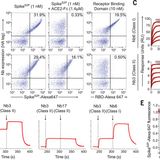RECENT ARTICLES

An ultrapotent synthetic nanobody neutralizes SARS-CoV-2 by stabilizing inactive Spike
Monoclonal antibodies that bind to the spike protein of severe acute respiratory syndrome coronavirus 2 (SARS-CoV-2) show therapeutic promise but must be produced in mammalian cells and need to be delivered intravenously. By contrast, single-domain antibodies called nanobodies can be produced in bacteria or yeast, and their stability may enable aerosol delivery. Two papers now report nanobodies that bind tightly to spike and efficiently neutralize SARS-CoV-2 in cells. Schoof et al. screened a yeast surface display of synthetic nanobodies and Xiang et al. screened anti-spike nanobodies...…Monoclonal antibodies that bind to the spike protein of severe acute respiratory syndrome coronavirus 2 (SARS-CoV-2) show therapeutic promise but must be produced in mammalian cells and need to be delivered intravenously. By contrast, single-domain antibodies called nanobodies can be produced in bacteria or yeast, and their stability may enable aerosol delivery. Two papers now report nanobodies that bind tightly to spike and efficiently neutralize SARS-CoV-2 in cells. Schoof et al. screened a yeast surface display of synthetic nanobodies and Xiang et al. screened anti-spike nanobodies...WW…

An ultrapotent synthetic nanobody neutralizes SARS-CoV-2 by stabilizing inactive Spike
The SARS-CoV-2 virus enters host cells via an interaction between its Spike protein and the host cell receptor angiotensin converting enzyme 2 (ACE2). By screening a yeast surface-displayed library of synthetic nanobody sequences, we developed nanobodies that disrupt the interaction between Spike and ACE2. Cryogenic electron microscopy (cryo-EM) revealed that one nanobody, Nb6, binds Spike in a fully inactive conformation with its receptor binding domains (RBDs) locked into their inaccessible down-state, incapable of binding ACE2. Affinity maturation and structure-guided design of...…The SARS-CoV-2 virus enters host cells via an interaction between its Spike protein and the host cell receptor angiotensin converting enzyme 2 (ACE2). By screening a yeast surface-displayed library of synthetic nanobody sequences, we developed nanobodies that disrupt the interaction between Spike and ACE2. Cryogenic electron microscopy (cryo-EM) revealed that one nanobody, Nb6, binds Spike in a fully inactive conformation with its receptor binding domains (RBDs) locked into their inaccessible down-state, incapable of binding ACE2. Affinity maturation and structure-guided design of...WW…
- Total 2 items
- 1